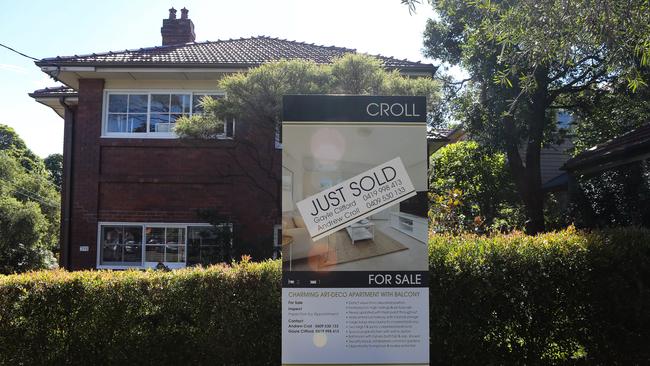Housing comes off the boil as fixed rates rise
The housing boom is fading with prices in Sydney and Melbourne peaking as fixed mortgage rates continue to rise and investors prepare for official hikes.

The housing boom is fading with prices in Sydney and Melbourne peaking as fixed mortgage rates continue to rise and investors prepare for the first hikes in official interest rates since 2010.
Sydney house prices fell 0.2 per cent in March, their second monthly fall in a row, and Melbourne lost 0.1 per cent, according to CoreLogic. The national capital city average rose 0.3 per cent, the equal slowest pace since October 2020, and the year-on-year growth rate slowed to 16.3 per cent.
Housing markets in other parts of the country are “still hot”, with prices up 2 per cent in Brisbane, 1.9 per cent in Adelaide, and 1 per cent in Perth, Darwin and Canberra last month, and Sydney and Melbourne are “far from weak”, according to CBA’s head of Australian economics, Gareth Aird.
But the RBA will need to assess the impact of rate hikes on the economy, particularly the household sector and the housing market – when it starts to tighten monetary policy in the coming months.
“That assessment means that we expect the central bank to be patient and a gradual and a shallow rate hike trajectory is our base case,” said Aird.
He expected the RBA to be “cognisant of the nexus between changes in interest rates and the impact on home prices, household behaviour and the broader economy” as rising interest rates would generate changes in behaviour, which in turn would impact economic outcomes.
Aird estimated that more than a million home borrowers have never experienced rate hikes and their impact on mortgage rates, economic activity and the housing market.
It came as Australian Bureau of Statistics data showed new loan approvals fell 3.7 per cent month-on-month in February versus an expected 1.5 per cent rise. Loans to owner-occupiers dived 4.7 per cent and investor loans fell 1.8 per cent, adding to evidence of a slowdown in the housing market.
According to the Reserve Bank, advertised fixed rates for owner-occupiers have risen 134 basis points since April 2021 and at 3.48 per cent were at their highest level since June 2019.
NAB’s director of economics, markets, Tapas Strickland, said the fall in Sydney and Melbourne house prices signalled the “peak in the house price cycle is likely near with affordability constraints biting alongside a rise in fixed rates”.
NAB expected the housing market to slow further in 2022 before outright declines in 2023 as mortgage rates rise, but Mr Strickland said Friday’s data suggested “the risk that we may see mild declines nationwide in 2022 given the slight falls seen in Sydney and Melbourne.”
He noted that recent consumer confidence showed attitudes to buying a dwelling sank to their lowest level since June 2008. NAB expects the first RBA rate hike to come by August.
Capital Economics economist Ben Udy agreed that while house prices should start falling across the eight capital cities in 2023, the recent price declines in Sydney and Melbourne in March suggested “the downturn could be starting sooner than we had anticipated”.
CBA sees an “orderly correction” in house prices of 8 per cent in 2023.
But CBA’s house price forecasts assume a “gradual and shallow” official interest rate tightening cycle that takes the cash rate to 1.25 per cent by the March quarter of 2023 and stays there through 2023.
The money market has a cash rate of 2.19 per cent priced in by the March quarter of 2023.
“Our expectation is that the RBA holds the cash rate at 1.25 per cent over 2023 as the Australian household sector adjusts to higher interest rates,” said Aird.
“There is a lagged impact on changes in the cash rate and the impact on home prices and the broader economy so we anticipate that home prices will correct lower over 2023 despite our call for the RBA to be on hold for most of next year.”
CBA sees the RBA’s rates “lift-off” occurring in June because the economy will be at full employment and annual wages growth will be on an accelerating path to the desired level of 3 per cent.
“Stronger wages growth will provide a partial offset to rising interest rates on the property market,” Aird said.
“In addition, a lift in population growth as the international border reopens will boost the underlying demand for bricks and mortar, particularly inner city apartments.”
House price gains nationally rose an “extraordinary” 21 per cent in 2021 thanks to the unprecedented monetary and fiscal policy stimulus unleashed during Covid.
A “correction lower” in the market would be a “natural response to rising interest rates given it was record low interest rates that drove the phenomenal lift in prices in 2021”.




To join the conversation, please log in. Don't have an account? Register
Join the conversation, you are commenting as Logout